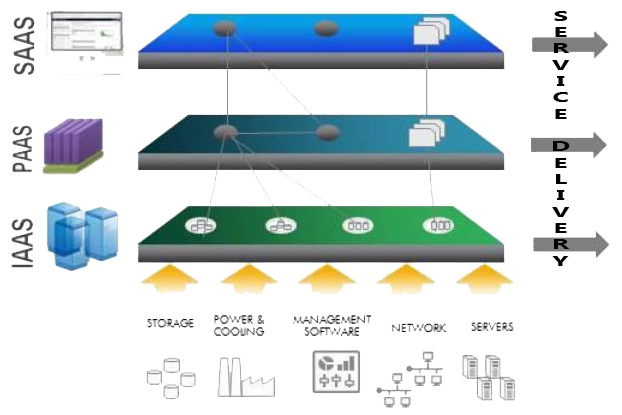What is the fuzz about?
It’s been more than a decade that “cloud computing” as a modern term is around us. I think that the technology was available and in use for much more time. The example is the good old web hosting. You were able to purchase a domain name and hosting by nothing but a few clicks and a credit card long before anyone even mentioned Cloud computing?! When the industry needed a new racing horse, entrepreneurial marketing gurus and CEO`s seized the opportunity. They made a sounding name and started selling it as a separate and unique technology.
Cloud origins
I would make a bold statement and say that cloud computing has its roots in engineers laziness. I mean we do not like repetitive tasks, don’t we? So we started working on automatization in a way that it would do those tasks for us. When enough automation happened, there was a possibility to pack it and sell it as a product or set of products, labeled as Cloud – something.
There goes another bold one. Virtualization was and still is foundation pillar of cloud computing. It made enough difference and free time so smart people were able to do more creative things than just the usual work.
If we talk about the date of origin of the cloud computing as a term in modern days it would be August 9, 2006, when Google CEO Eric Schmidt introduced the term to an industry conference.
What is the “Cloud computing” anyway?

It would be using ICT resources from within the organization, or from somebody else’s platform, (typically Storage, Memory, CPU, Networking, OS, and Applications) with a few practical advances. Those advances are: Easiness of use, Self-service, Scalability, Anytime anywhere access, and Pay per use. Cloud services could be divided by type into Public, Private or Hybrid. Next type of classification is by form. There is Infrastructure as a Service, Platform as a Service, and Software as a Service or IaaS, PaaS, and Saas. I will not write about those into much details, there are plenty of articles around, so if interested, just Bing it or Google it or research however you prefer. Just a few definitions in the next paragraph.
Cloud computing by type
Public Cloud
Cloud computing solution in which organization, in this case, Service provider, offers resources like virtual machines, applications, network or a storage for third party users, like general public typically over the Internet.
Private Cloud
Cloud that organization hosts on-premises, for itself and its users. It delivers same advantages of cloud computing like self-service and scalability.
Hybrid Cloud
Hybrid cloud is the environment which uses a mix of on-premises, private cloud and third-party, public cloud services with automatic orchestration between the two or more platforms. Regarding user experience, it is a single platform.
Cloud computing by form

Infrastructure as a Service or IaaS
It is a form of cloud computing that provides computing resources for free or for rent over the Internet. In this model cloud service provider hosts hardware, servers, networking equipment, storage, software and other infrastructure equipment in order to provide infrastructure service for its users. It is a usually base foundation for other forms of cloud computing like Paas and SaaS.
Platform as a Service or PaaS
In this form of cloud computing cloud service provider has hardware (it would be Iaas) and on top of it some software tools, usually needed for application development, and it provides it to its users as a service over the Internet.
Software as a Service or SaaS
Is a cloud computing model for software distribution. It means that cloud service provider hosts applications and makes them available over the Internet. Again IaaS is the foundation and software sit on top of it.
CAPEX vs OPEX
In financial meaning, cloud computing gave the organizations and companies option to move from CAPEX to OPEX oriented businesses in terms of ICT. The main advantage was much much smaller start-up costs while retaining high-quality level.
It meant that more and more companies were able to afford better starting positions regarding ICT services, therefore, focusing its resources on business goals. In many cases, it was a game changer. Not to complicate too much, in a financial aspect it at least brought new ways or options of helping business. It also helped IT departments to move from being strictly cost centers to become cost – income centers within the company or an organization.
Time is of the essence for business
Traditional IT, as a business supporter was not fast enough to answer to all business demands.
Virtualisation helped much while cloud computing answered some unanswered questions.
It provided users with the best feature relating time – Self-service. What does it mean? It means that in ideal world user would be able to self-create needed service by few clicks, and even without contacting IT department. That is ideal world situation, the reality is in most cases still far away from there. Most obvious reason is that not all business activities are the same and repetitive. It means that you can not map, and automate all the tasks regarding business needs from ICT.
IT guys losing jobs over Cloud?

ICT industry is one of the fastest changing industries today. In some cases what you learn today, tomorrow may be different. You always need to stay in the game and learn. That is why some IT certificates are valid for only a few years, and then you need to be recertified. It is a fast-changing technology. So what is with traditional IT guys? Well, some of their daily tasks were automated, so they could do more creative things.Things like creating new services, improving existing ones etc. I don`t think the idea and what is happening with the Cloud computing is to get rid of the workers, but to allow them to do more productive and creative tasks. At the end, I think that it created more workplaces than it made obsolete.
Cloud or a Mist
Not so long ago everyone tried to stick a word Cloud in every possible service. There were many non-cloud services called Cloud-something just to get customers and grab the attention. Real cloud service providers called that type of service providers “Mist” providers. There was a statement that whatever is not a cloud it could only be the mist. It was a pejorative statement with the intention to draw a line between cloud and other types of IT services or computing. These days it would be quite ridiculous. Now there is indeed a new type of computing on the horizon. It is called “Mist computing”. It is a subject for another article, and for now, we will stick to the cloud.
Temporary conclusion
At the end, the idea for this article was to provide some basic insights into cloud computing terminology and definitions on the one page, without the need of following countless links. The subject is so big that people and organizations are writing numerous books about it. I also tried to shade some light on a subject from different perspectives, and show that as every technology, it has its good and bad sides. Here are few of the biggest CSP in the world today:
Amazon Web Services
Microsoft Azure
IBM
Google Cloud Platform
Salesforce.com
Alibaba Cloud Compute Service
Rackspace
Oracle
SAP
ServiceNow
Unfortunately, this must be done with links :).If you explore their portals, you may see that some were focused on common general services, but there are also others focused on their own proprietary products. Each of them is targeting its niche on the market, and all are expanding rapidly in last few years, so it is easy to conclude that more and more money will be in this industry in days to come.
Thank you for reading,

Microsoft focusing on its Azure cloud at the regional conference.

